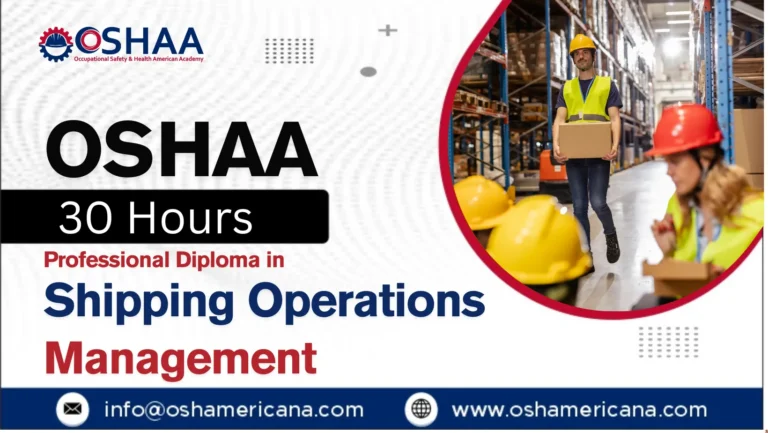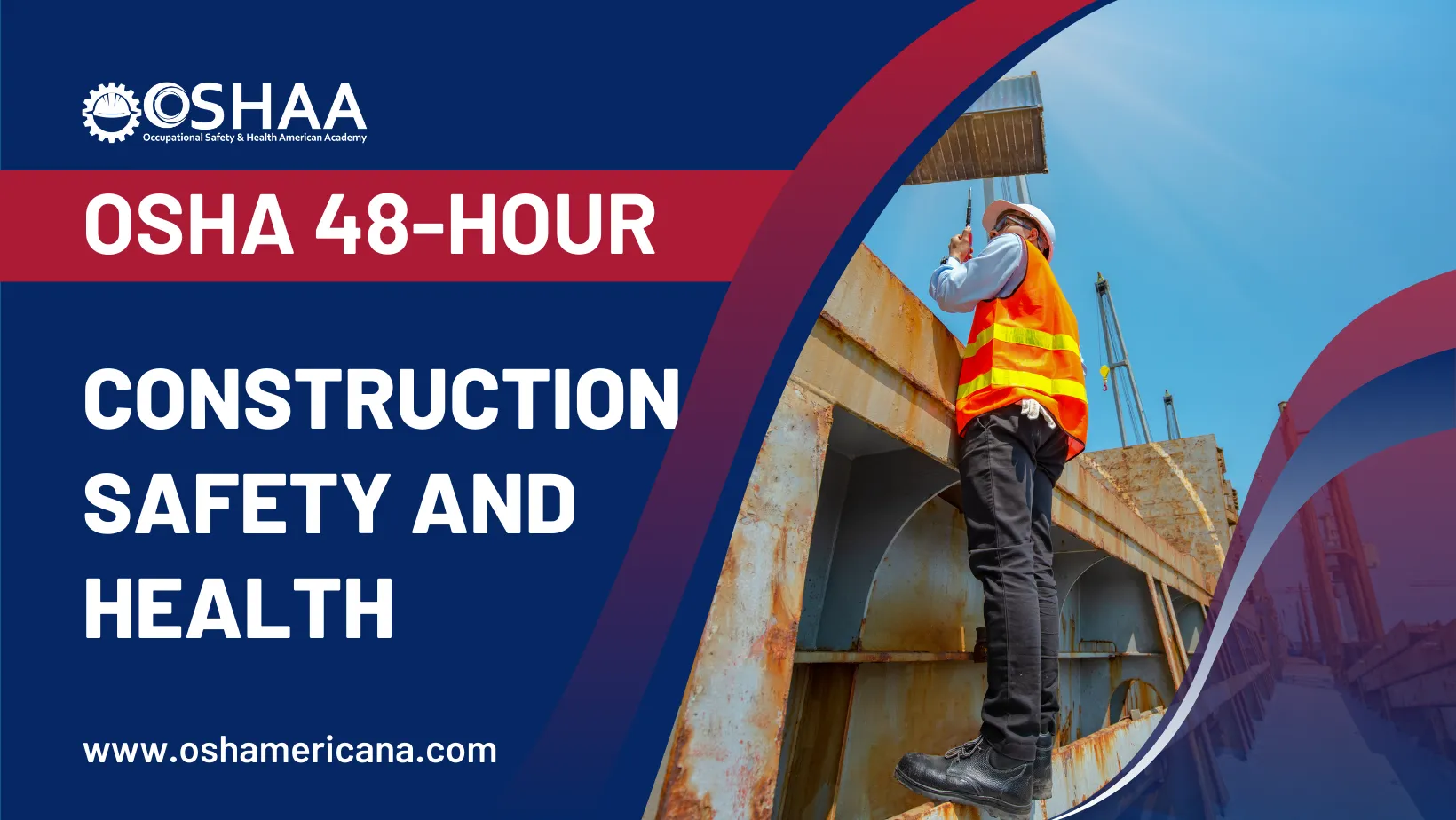Advance with the OSHA 48-Hour Oil and Gas Safety and Health Course. Gain expertise in OSHA standards, hazard management, and safety leadership for career growth.
The OSHA 48-Hour Oil and Gas Safety and Health Course is a comprehensive training program designed to prepare professionals for the demanding challenges of the global oil and gas industry. This advanced course equips participants with a deep understanding of OSHA standards, regulatory compliance, and hazard management, ensuring they are fully capable of addressing the complex safety needs of exploration, drilling, refining, and distribution operations. By combining compliance expertise with practical safety leadership skills, the OSHA 48-Hour Oil and Gas Safety and Health training offers participants the tools to build safer workplaces and stronger careers.
In the high-risk environment of oil and gas, safety is not optional but absolutely essential. The OSHA 48-Hour Oil and Gas Safety and Health Course emphasizes the importance of identifying hazards, preventing accidents, and ensuring compliance with both OSHA regulations and international best practices. The course is structured to address the realities faced in drilling sites, refineries, offshore platforms, and extensive pipeline systems, where even minor lapses in safety can result in serious consequences. Through this training, participants gain the knowledge required to safeguard workers, protect the environment, and maintain operational continuity in some of the world’s most challenging industrial settings.
Unlike general workplace safety programs, the OSHA 48-Hour Oil and Gas Safety and Health Course provides a specialized focus on the unique risks of the sector. Learners develop proficiency in hazard recognition, regulatory frameworks, emergency response strategies, and environmental protection measures. They also gain practical insight into leadership approaches that strengthen organizational safety culture, ensuring that compliance is not just achieved but consistently maintained across all levels of operation. This balance of technical knowledge and applied skills makes the training highly relevant for both individuals seeking career advancement and organizations aiming to improve overall safety performance.
Completing the OSHA 48-Hour Oil and Gas Safety and Health Course is more than meeting a compliance standard—it is a strategic investment in professional growth and organizational resilience. Graduates of the program earn a qualification that is widely recognized across the oil and gas industry, enhancing their career prospects and positioning them as reliable experts in occupational safety and health. Employers increasingly value professionals who can integrate OSHA standards into daily operations while fostering a proactive culture of safety, making this certification an asset for both personal and organizational success.
Ultimately, the OSHA 48-Hour Oil and Gas Safety and Health Course stands as a benchmark in industry training, blending regulatory expertise, hazard management, and leadership development into a single transformative program. By enrolling in this course, participants take an important step toward advancing their careers, strengthening workplace safety, and contributing to the long-term sustainability and responsibility of the global oil and gas sector.
OSHA 48-Hour Oil and Gas Safety and Health
To enroll in the OSHA 48-Hour Oil and Gas Safety and Health Course, learners are expected to meet the following criteria:
- Age Requirement
Participants in the OSHA 48-Hour Oil and Gas Safety and Health Course must be at least 18 years of age at the time of enrollment. This minimum age requirement ensures that learners have the maturity and responsibility necessary to engage with advanced occupational safety and health training. - Educational Background
A high school diploma or equivalent is strongly recommended for those enrolling in the OSHA 48-Hour Oil and Gas Safety and Health Course. While not mandatory, individuals with higher education in engineering, construction, occupational safety, or related technical fields may find the training particularly advantageous, as it builds on foundational knowledge to deepen understanding of OSHA standards and oil and gas safety practices. - Work Experience
Prior industry experience is not required to enroll in the OSHA 48-Hour Oil and Gas Safety and Health Course. However, professionals already working in oil and gas operations, construction, or safety management may find that their background enhances their ability to apply the knowledge gained. The course is equally valuable for newcomers seeking to establish a strong foundation in OSHA compliance and oil and gas safety protocols. - English Proficiency
To successfully complete the OSHA 48-Hour Oil and Gas Safety and Health Course, learners must have the ability to read, write, and speak English. Proficiency in English is essential to understanding course materials, regulatory standards, and safety procedures, ensuring that participants can fully engage with the training and apply OSHA requirements effectively in real-world scenarios.
Study Units
Learning Outcomes
1. Introduction to OSHA and Oil and Gas Industry
- Understand the role and mission of OSHA in regulating workplace safety.
- Identify key OSHA standards and regulations applicable to the oil and gas industry.
- Describe the importance of compliance with OSHA regulations for ensuring worker safety.
2. Regulatory Compliance in Oil and Gas Operations
- Explain specific OSHA regulations and industry standards relevant to oil and gas operations.
- Demonstrate knowledge of compliance requirements for drilling, refining, and pipeline activities.
- Develop strategies to maintain regulatory compliance and avoid penalties.
3. Hazard Identification and Risk Assessment
- Identify potential hazards in various oil and gas work environments, such as drilling rigs, refineries, and pipelines.
- Conduct thorough risk assessments to prioritize hazards based on severity and likelihood.
- Implement control measures to mitigate identified risks and ensure a safer work environment.
4. Personal Protective Equipment (PPE)
- Identify different types of PPE required for oil and gas operations, including respiratory protection, eye and face protection, and protective clothing.
- Demonstrate proper selection, use, and maintenance of PPE to minimize exposure to workplace hazards.
- Train workers on the importance of wearing PPE and ensure compliance with PPE protocols.
5. Process Safety Management (PSM)
- Understand the principles and requirements of OSHA’s Process Safety Management (PSM) standard (29 CFR 1910.119).
- Implement PSM elements, including process hazard analysis, operating procedures, and mechanical integrity, to prevent major incidents.
- Conduct audits and inspections to verify compliance with PSM standards and improve safety performance.
6. Emergency Preparedness and Response
- Develop and implement emergency action plans (EAPs) tailored to oil and gas operations.
- Train employees on emergency response procedures for fires, spills, explosions, and other incidents.
- Coordinate with emergency response teams and agencies to ensure effective response and mitigation of emergencies.
7. Health Hazards in the Oil and Gas Industry
- Identify and assess health hazards specific to the oil and gas industry, such as exposure to toxic chemicals, confined spaces, and ergonomic risks.
- Implement controls to minimize health risks and promote worker well-being through health monitoring and education programs.
- Ensure compliance with OSHA standards and industry best practices for occupational health.
8. Environmental Protection and Sustainability
- Describe environmental regulations and sustainability practices applicable to oil and gas operations.
- Implement measures to minimize environmental impact, including waste management, pollution prevention, and conservation efforts.
- Monitor environmental performance and implement corrective actions to achieve regulatory compliance and improve sustainability practices.
9. Safety Leadership and Culture
- Foster a strong safety culture within the organization through leadership commitment and employee engagement.
- Promote safety awareness and behaviors among workers through training, communication, and recognition programs.
- Continuously improve safety performance by encouraging feedback, participation, and continuous learning.
10. Incident Investigation and Reporting
- Conduct thorough investigations of incidents, near misses, and accidents to determine root causes and contributing factors.
- Develop corrective and preventive actions to prevent recurrence of incidents.
- Communicate findings effectively through incident reports and recommendations for improvement.
11. Contractor Safety Management
- Implement safety protocols and standards for contractors working on oil and gas sites.
- Evaluate contractor safety performance and ensure compliance with safety requirements and regulations.
- Provide training and resources to contractors to promote a safe working environment and prevent incidents.
12. Tools and Equipment Safety
- Identify safety hazards associated with tools and equipment used in oil and gas operations, such as hand tools, machinery, and specialized equipment.
- Implement safety procedures for the proper use, inspection, and maintenance of tools and equipment.
- Train workers on safe operating practices and ensure compliance with safety protocols to prevent injuries and accidents.
These learning outcomes are designed to equip participants with the knowledge, skills, and competencies necessary to effectively manage safety and health in the challenging and high-risk environment of the oil and gas industry.
The OSHA 48-Hour Oil and Gas Safety and Health course is meticulously designed to equip professionals, supervisors, and organizational leaders in the oil and gas industry with advanced safety knowledge, practical skills, and compliance expertise. This course addresses the critical safety challenges inherent in high-risk operations, offering participants the tools to minimize workplace hazards, adhere to OSHA standards, and enhance overall operational efficiency. Recognized globally, it supports professional development, regulatory compliance, and organizational resilience, positioning participants as safety-conscious leaders in the oil and gas sector.
Key Benefits of the Course
- Comprehensive Knowledge of OSHA Standards
Gain in-depth understanding of OSHA regulations specific to the oil and gas industry. Learn how to interpret and implement standards to ensure full compliance, protect employees, and reduce legal liability. - Enhanced Workplace Safety
Develop the skills to identify, assess, and mitigate hazards in drilling, production, and refining environments. Reduce workplace incidents through proactive safety management strategies. - Risk Management and Emergency Preparedness
Learn to implement effective risk assessment procedures and emergency response plans. Be prepared for incidents such as fires, chemical spills, and equipment failures to minimize operational downtime and human injury. - Regulatory Compliance and Legal Protection
Equip your organization with the knowledge to meet OSHA and local regulatory requirements. Reduce exposure to fines, legal claims, and reputational damage by ensuring compliance at all operational levels. - Practical Hazard Identification and Control Skills
Master hands-on techniques to identify hazards, conduct inspections, and implement control measures. Improve safety protocols that directly impact employee protection and operational efficiency. - Leadership and Safety Culture Development
Strengthen leadership abilities to foster a culture of safety across teams. Develop skills in communication, supervision, and safety advocacy to inspire proactive risk management among staff. - Professional Development and Career Advancement
Enhance your credentials as a certified safety professional. The course provides globally recognized skills and knowledge, increasing employability and career progression opportunities in the oil and gas sector. - Operational Efficiency and Cost Savings
Apply safety management practices that reduce accidents, minimize downtime, and prevent equipment damage. Drive cost savings while improving workflow and productivity. - Worker Well-Being and Productivity
Promote employee health and morale by implementing safer work environments. Reduce injury-related absences and improve workforce engagement and efficiency. - Emergency Response and Crisis Management Skills
Gain expertise in handling high-pressure situations effectively. Learn structured approaches for crisis communication, evacuation, and disaster mitigation in oil and gas operations. - Continuous Improvement and Safety Innovation
Cultivate skills to continuously analyze, improve, and innovate safety procedures. Introduce new safety technologies, processes, and best practices to maintain industry-leading standards. - Cross-Functional Collaboration and Communication
Improve coordination between operations, maintenance, and management teams. Enhance reporting, documentation, and communication practices to support a unified approach to safety. - Global Best Practices and Industry Standards
Learn internationally recognized safety practices, aligning your operations with global benchmarks. Strengthen the organization’s reputation for excellence in health, safety, and environmental management. - Incident Investigation and Reporting Skills
Develop the ability to conduct thorough incident investigations, identify root causes, and implement corrective actions. Minimize recurrence and enhance organizational learning. - Strategic Safety Planning and Policy Development
Acquire expertise in designing, implementing, and evaluating organizational safety policies. Ensure long-term sustainability, regulatory compliance, and a robust safety culture within the organization.
The OSHA 48-Hour Oil and Gas Safety and Health Course is designed for a wide spectrum of professionals and stakeholders engaged in oil and gas operations worldwide. It is particularly relevant to individuals and organizations committed to advancing workplace safety, ensuring regulatory compliance, and strengthening professional expertise in one of the world’s most high-risk industries. This training provides vital knowledge for those at management, technical, regulatory, and consultancy levels who play a direct or supporting role in safeguarding workers, facilities, and the environment.
1. Safety Managers and Coordinators
- Oversee the design, implementation, and monitoring of safety programs in oil and gas facilities.
- Gain in-depth knowledge of OSHA regulations, workplace hazard identification, and proactive risk management strategies.
- Enhance their ability to foster a culture of safety and lead continuous improvement initiatives across operations.
- Strengthen compliance with international workplace safety standards, reducing incidents and promoting accountability.
2. Operations Managers and Supervisors
- Manage day-to-day operations in drilling, refining, and pipeline activities where safety challenges are significant.
- Learn to integrate OSHA training into operational workflows while maintaining productivity and efficiency.
- Develop advanced skills to enforce site-level safety protocols and corporate safety policies consistently.
- Reduce workplace accidents and downtime by applying proactive supervision and compliance measures.
3. Environmental Health and Safety (EHS) Professionals
- Conduct occupational health assessments, risk evaluations, and environmental safety audits.
- Strengthen expertise in aligning oil and gas operations with OSHA standards and international best practices.
- Gain tools to identify hazards early, implement corrective measures, and protect employee health.
- Support sustainable operations by balancing environmental protection with safety performance.
4. Engineers and Technicians
- Involved in the design, maintenance, and inspection of oil and gas facilities, equipment, and pipelines.
- Understand how engineering decisions impact workplace safety and compliance requirements.
- Learn to apply OSHA regulations to technical operations, ensuring safer processes and equipment reliability.
- Enhance their ability to integrate safety into engineering designs and maintenance procedures.
5. Compliance Officers
- Monitor and enforce adherence to OSHA and other regulatory safety standards within oil and gas companies.
- Gain structured knowledge of auditing processes, reporting systems, and corrective action plans.
- Improve capabilities in identifying compliance gaps and mitigating risks before they escalate.
- Protect organizations from penalties, reputational harm, and operational delays due to non-compliance.
6. Emergency Response Teams
- Respond to incidents including fires, explosions, chemical spills, and confined space emergencies.
- Learn advanced emergency planning, incident command systems, and crisis management techniques.
- Improve their ability to act swiftly and effectively during emergencies, reducing loss of life and property.
- Gain confidence in coordinating response efforts while adhering to OSHA safety requirements.
7. Contractors and Subcontractors
- Provide specialized services in oil and gas operations under strict safety regulations.
- Learn to align work practices with OSHA training and client-specific safety standards.
- Understand how third-party compliance directly impacts overall site safety and operational integrity.
- Improve their ability to meet contractual safety obligations while protecting their workforce.
8. Health and Safety Consultants
- Deliver expert guidance to oil and gas companies on compliance, safety, and training.
- Use this course as an advanced credential to offer updated, OSHA-compliant recommendations.
- Expand consultancy services by aligning expertise with international occupational safety protocols.
- Enhance professional credibility by applying globally recognized safety training knowledge.
9. Regulatory Personnel
- Represent government agencies and industry bodies tasked with enforcing occupational safety standards.
- Gain deeper insights into OSHA regulations and their application within oil and gas operations.
- Improve their ability to conduct inspections, audits, and investigations with precision and authority.
- Contribute to stronger enforcement of workplace safety and environmental regulations.
10. Risk Management Professionals
- Specialize in identifying, analyzing, and mitigating operational risks in high-hazard oil and gas environments.
- Learn to apply structured risk management frameworks that prioritize safety and efficiency.
- Strengthen expertise in balancing hazard control with business continuity and operational resilience.
- Support organizations in achieving long-term safety performance and regulatory compliance goals.







